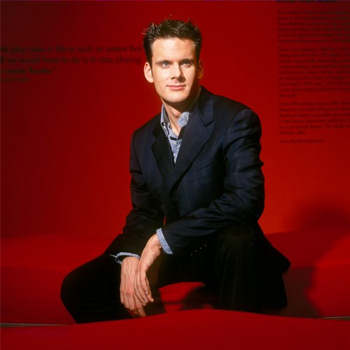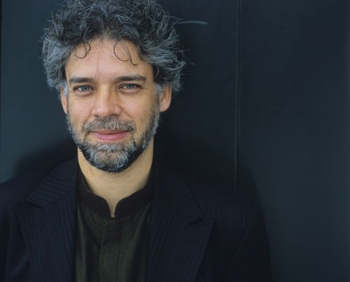Other Links
Editorial Board
- Editor - Bill Kenny
- London Editor-Melanie Eskenazi
- Founder - Len Mullenger
Google Site Search
SEEN
AND HEARD CONCERT REVIEW
Mahler and Mozart : François-Frédéric
Guy (piano) Philippe Jordan (conductor), Philharmonia Orchestra,
Royal Festival Hall, South Bank, London 13.3.2008 (AO)
Mahler : Symphony No 5
Mozart : Piano
Concerto No 21 in C
Pay attention to the pairings on a programme because they aren’t
there just by chance. Things are paired for a purpose, so
understanding the musical logic tells something about the
performance. Pairings are even more critical in the case of
Mahler’s Fifth Symphony, which lends itself to different
approaches. It’s a perennial crowd-pleaser, and many popular
performances play to the assumption that noise equals
“excitement”. But Mahler is not quite so simple.
Jordan’s approach to
Mahler is equally lucid. The Fifth Symphony may start with the
trumpet but that’s perhaps one of Mahler’s quirky ironies. He
writes in lots of brass, but it’s deceptive. This symphony is not
all blast and fanfare. Indeed, he had it premiered in Vienna’s
Kleinen Musikvereinsaal, to emphasize its “Kammermusikton”.
Thus Jordan concentrates on the symphony’s chamber-like
qualities. Just as Mozart embedded sub-groups (particularly
strings) into his concerto, Mahler embeds within his symphony
different units which function like miniature chamber ensembles.
There are interlocking dialogues, between trumpet and horn,
between horn and flute, solo violin and strings. The trumpet part
is important, but it weaves in and out throughout, leading and
tantalizing, much in the way the piano acts in Mozart. There are
even parallels in thematic material. Mozart incorporates a slow,
ceremonial pace lends stylized classicism, just as Mahler’s use of
march themes underpins more lively outbursts. This certainly
doesn’t mean that Mozart influenced Mahler or anything quite as
simplistic as that : but listening to the way these pieces were
performed together was illuminating, each enhancing the other.
Above all, in this performance, Jordan captured the energy that
infuses both pieces with ebullient vividness.

Philippe Jordan -
Picture © J Ifkovits
By starting with
Mozart’s Piano Concerto no 21, Philippe Jordan makes a distinct
statement. It’s an elegantly crafted piece where clarity is
essential.
François-Frédéric
Guy’s fluid technique allowed it to sparkle, his notes rippling
across the keyboard, lucid and expressive. When the orchestra
joined in, the melodic line surged sensuously. Guy’s long cadenzas
were written specially for him by Marc Monnet. They make the most
of his swift, flowing style, at once delicate and assertive, and
full of vivacity.

François-Frédéric Guy
- Picture © Guy Vivien
The orchestral playing
was superb, even by this orchestra’s usually high standards.
Jordan’s emphasis on the chamber-like relationships paid off
because he was working with musicians of this very high calibre.
Some of the solos were stunning, such as the clarinet and first
violin, but overall this was unusually dynamic playing, as the
orchestra seemed invigorated with enthusiasm. Because it lends
itself to energetic treatment, this symphony often comes off
successfully when played by youth orchestras – Barshai and the
Junge Deutsche Philharmonie being my favourite of these, by far.
But what a joy it is to hear it played by musicians as good as
the Philharmonia, who can capture subtle nuances in the most
familiar phrases ! It really makes a difference because so much in
this symphony is bound up in intricate inner relationships. When
they are as lucidly played as this, they come over elegantly –
something not often appreciated in Mahler, but present,
nonetheless.
The refinement of this
performance though, existed in the service of a much deeper
interpretation.
It’s a significant
insight, for Mahler nearly died in 1901, while this symphony was
in gestation. Indeed, the symphony was first performed with the
Rückert setting, Um Mitternacht. In the silence of the
night the poet hears his heart and realizes its beati separates
life from death. Rückert places his faith in God, but for Mahler,
more deist than true believer, it’s more complex. The
Trauermarsch in this symphony is counterbalanced by the
passionate Adagietto and Finale. It’s dangerous to
overemphasize the “Alma” connection, but this is music of positive
energy. This performance was particularly satisfying because all
the loving detail that came before served. logically and
inexorably towards this powerful conclusion. The spontaneity and
freedom that had characterized the Mozart performance re-surfaced
in the life-affirming vitality that
Jordan finds in
Mahler’s Fifth.
I wanted to attend
this performance to hear what Jordan would make of it, as I’ve
been very impressed by his work so far. He’s only 33 years old,
yet already distinctive and individual. Look out for his
recording of Busoni’s Doktor Faustus, from Zürich, which is
one of the best. Only last week, he conducted Strauss’s
Salome
at the Royal Opera House. His father is, I believe, the much respected Armin
Jordan, whose
Mahler is very good. Truly we are fortunate to be in an era when
so many progressive, intelligent conductors are coming
into prominence !
Heavy-handed approaches will always plague us, but Jordan’s
innovative, spirited originality shows real insight into Mahler’s
idiom. Performances like this help restore faith in the future.
Anne Ozorio
Back
to Top
Cumulative Index Page
